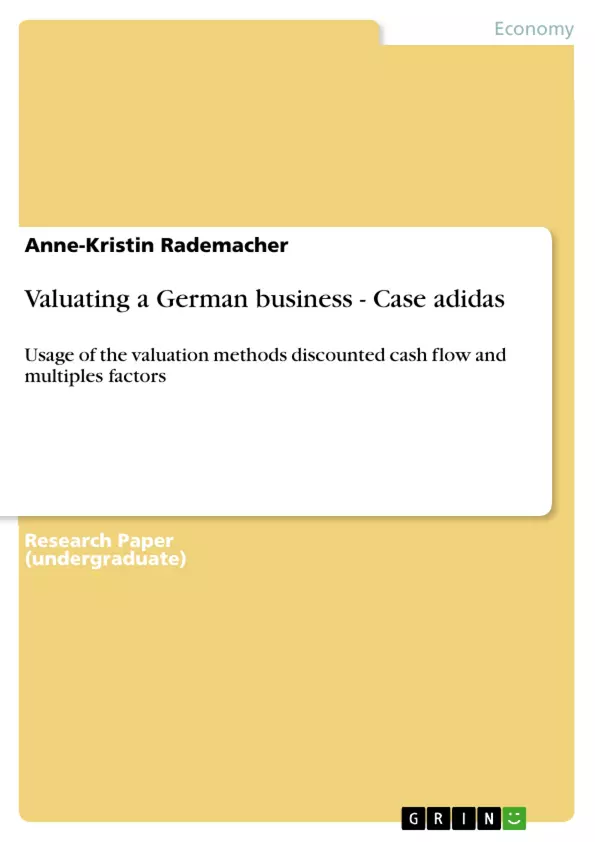Valuation of companies is done for many reasons. The evaluation of alternative strategies for decisions to sell or buy a company is the widest known purpose among literature. The alternatives can be categorized into three parts: mergers and acquisitions, succession and continuation. The former reflects the selling or buying decision of companies, and the acquisition of shares and mergers. Succession means management buyouts, whereas continuation refers to reorganization, monitoring of financial standing and liquidity flotation, investments but also divestments and spin offs (cf. Hansa & Dvorak 2007).
Adidas has gone through several valuations already. In 1994 Adidas was sold for 1,350 million German Mark whereas in mid-1995 the company was already valued at 3,300 million German Mark when it was initially offered to public (cf. Die Welt 1995). As of December 31st 2010 the price for an Adidas share was 48.89 Euro (€), reflecting a 29.4% growth compared to 2009 (cf. Adidas 2011 a, p. 2).
The following paper on hand values the German company Adidas as of December 2010 with help of the valuation methods Discounted Cash Flow in terms of equity and entity approach as well as the market oriented multiples. Both valuation methods are theoretical defined and later applied to Adidas.
Table of Contents
- Executive Summary
- List of Figures
- List of Tables
- List of Abbreviations
- 1 Introduction
- 2 Theoretical foundation of valuation models
- 2.1 Discounted cash flow
- 2.1.1 Discounting
- 2.1.2 Free Cash flows
- 2.1.2 Discounting rates – The costs of capital
- 2.2 Valuation using Multiples
- 2.1 Discounted cash flow
- 3 Assessment of Adidas
- 3.1 Adidas in figures
- 3.2 Strategy and planning
- 3.3 Market analysis and competition
- 4 Applying valuation methods
- 4.1 Valuation of Adidas with the DCF approach
- 4.1.1 Forecasts of the free cash flows
- 4.1.2 Determination of the CAPM and WACC
- 4.1.3 Calculation of the shareholder value
- 4.2 Multiples factors
- 4.2.1 Definition of qualified multiples and peer group
- 4.2.2 Formation of the multiples
- 4.1 Valuation of Adidas with the DCF approach
- 5 Comparison and assessment of the results
Objectives and Key Themes
This paper analyzes the valuation of the German company Adidas as of December 2010 using two methods: discounted cash flow and market-oriented multiples. The paper aims to determine the realistic shareholder value of Adidas and compare the results of the two methods.
- Valuation of Adidas using discounted cash flow (DCF) approach
- Valuation of Adidas using market-oriented multiples
- Comparison and assessment of the results of both methods
- Analysis of Adidas's financial performance and market position
- Determination of the shareholder value of Adidas
Chapter Summaries
The paper begins with an introduction that provides context for the valuation of Adidas and outlines the paper's scope and objectives. Chapter 2 introduces the theoretical foundation of the valuation models used, focusing on discounted cash flow and valuation using multiples. This chapter explains the key concepts and methodologies used in the valuation process. Chapter 3 provides a comprehensive assessment of Adidas, including its financial performance, strategy, and market analysis.
Chapter 4 applies the valuation methods to Adidas. It details the forecasts of free cash flows, the determination of the CAPM and WACC, and the calculation of shareholder value using the DCF approach. It also defines qualified multiples and peer groups and forms the multiples for the second valuation method. Chapter 5 concludes by comparing and assessing the results of both methods.
Keywords
This paper focuses on the valuation of a company, specifically Adidas, using discounted cash flow (DCF) and market-oriented multiples. It explores concepts such as free cash flows, cost of capital, CAPM, WACC, and the formation of multiples for valuation. Key themes include financial performance analysis, market analysis, and the determination of shareholder value. The study provides a comprehensive analysis of Adidas's financial standing and future prospects.
- Citar trabajo
- Anne-Kristin Rademacher (Autor), 2012, Valuating a German business - Case adidas, Múnich, GRIN Verlag, https://www.grin.com/document/201566



